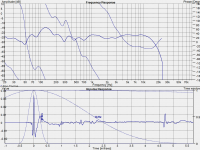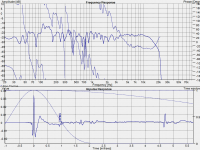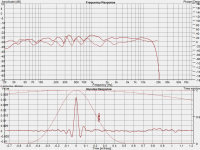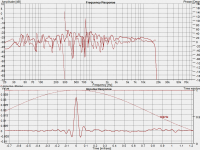Please take a look at the latest results with a new ESS9018 DAC
http://www.diyaudio.com/forums/multi-way/272781-advice-needed-4-way-loudspeaker-41.html#post4769009
http://www.diyaudio.com/forums/multi-way/272781-advice-needed-4-way-loudspeaker-41.html#post4769009
Hi Everyone, Just discovered RePhase and I have been very impressed with what I have seen. So my very sincere congratulations and thanks to Pos for making this beautiful piece of software available. I'm also a member of a small community of French enthusiasts trying to spread the word about it here: RePhase I have a naive question as a beginner with RePhase: I am trying to implement a 3rd order high-pass filter at 40Hz in my system. I would like this filter to be linear phase and able to run at 192kHz. How many taps would it require ? Is the default 8192 taps enough ? Is there any way to simulate that ? Thanks in advance.
Hello,
Glad you like rePhase!
Interesting topic and experiments there!
Regarding your question, after the impulse generation the red curves will show you exactly what the resulting magnitude and phase curve will look (correction alone or actual response if you loaded a measurement) for a given set of impulse settings (number of taps, sampling frequency, windowing, etc.).
In short the blue curves are the target, and the red ones the result.
Glad you like rePhase!
Interesting topic and experiments there!
Regarding your question, after the impulse generation the red curves will show you exactly what the resulting magnitude and phase curve will look (correction alone or actual response if you loaded a measurement) for a given set of impulse settings (number of taps, sampling frequency, windowing, etc.).
In short the blue curves are the target, and the red ones the result.
Hello,
Glad you like rePhase!
Interesting topic and experiments there!
Regarding your question, after the impulse generation the red curves will show you exactly what the resulting magnitude and phase curve will look (correction alone or actual response if you loaded a measurement) for a given set of impulse settings (number of taps, sampling frequency, windowing, etc.).
In short the blue curves are the target, and the red ones the result.
Hi Pos,
Thanks for answering. Much appreciated.
One more question which was a matter of debate was the appropriate window of measure prior to using RePhase. I kind of found out that using HOLMImpulse with the 'Frequency response smoothing' and the 'Complex Smoothing' was the most appropriate way to capture the best information to feed into RePhase and get the most linear phase through the whole frequency range. Would you agree or would you have any better suggestion, using REW for instance ?
There is no ideal measurement window (or distance, or technique) that will work all the time. It depends on the distance/position (mic, loudspeaker, boundaries), the number of ways, the frequency range, the things you are trying to correct, etc...
For example for phase-only corrections, you don't need high frequency resolution but you need to avoid reflections as much as you can, so manual gating is a good solution most of the time.
The lower you want to measure (ie longer gating) the closer you need to get from the loudspeakers, and as a consequence the less accurate you will be for HF and phase relation between ways.
So for a fullrange correction you will most likely need several measurements at different distances and gating length to get an accurate picture.
If those measurement are all exported with a similar centering and magnitude you can then drag and drop them on the rephase window one after the other to focus on a specific area.
For example for phase-only corrections, you don't need high frequency resolution but you need to avoid reflections as much as you can, so manual gating is a good solution most of the time.
The lower you want to measure (ie longer gating) the closer you need to get from the loudspeakers, and as a consequence the less accurate you will be for HF and phase relation between ways.
So for a fullrange correction you will most likely need several measurements at different distances and gating length to get an accurate picture.
If those measurement are all exported with a similar centering and magnitude you can then drag and drop them on the rephase window one after the other to focus on a specific area.
There is no ideal measurement window (or distance, or technique) that will work all the time. It depends on the distance/position (mic, loudspeaker, boundaries), the number of ways, the frequency range, the things you are trying to correct, etc...
For example for phase-only corrections, you don't need high frequency resolution but you need to avoid reflections as much as you can, so manual gating is a good solution most of the time.
The lower you want to measure (ie longer gating) the closer you need to get from the loudspeakers, and as a consequence the less accurate you will be for HF and phase relation between ways.
So for a fullrange correction you will most likely need several measurements at different distances and gating length to get an accurate picture.
If those measurement are all exported with a similar centering and magnitude you can then drag and drop them on the rephase window one after the other to focus on a specific area.
Hi Pos,
Thanks again for answering so quickly. What really struck me after trying your remarkable piece of SW was the quality of the impulse generated. So thanks very much again.
Prior to discovering RePhase, we (on the French forum) spent a considerable amount of time playing with Trinnov Amethyst and Dirac, which are not exactly comparable as they are aimed more at room correction than plain LS phase/time alignment but anyhow. What we found out was that, to get a comparable representation of phase between Trinnov and REW, we needed to use a measure window with variable length, ie 6 to 8 cycles.
This does obviously not protect from reflections, and the method you are suggesting probably is much more accurate that the one we found. But I guess that, if the goal is to spread the interest of phase correction, we need to find an easy way of measuring to propose to users, in order not to get them afraid by the difficulty to implement the concept. This would not be a perfect methodology, but a heuristic which works in most case.
In case you find out such heuristic method, please let me know.
Thanks.
Hi Pos, just a question, is a 64-bit version in the pipeline? Not saying it would make an audible difference, just checking.
Hi diyaudnut,
I am currently using a 64 bit machine, so it is possible that next versions will be 64bit only...
I don't know how many out there still use 32 bit machine ?...
Hi Pos,
Thanks again for answering so quickly. What really struck me after trying your remarkable piece of SW was the quality of the impulse generated. So thanks very much again.
Prior to discovering RePhase, we (on the French forum) spent a considerable amount of time playing with Trinnov Amethyst and Dirac, which are not exactly comparable as they are aimed more at room correction than plain LS phase/time alignment but anyhow. What we found out was that, to get a comparable representation of phase between Trinnov and REW, we needed to use a measure window with variable length, ie 6 to 8 cycles.
This does obviously not protect from reflections, and the method you are suggesting probably is much more accurate that the one we found. But I guess that, if the goal is to spread the interest of phase correction, we need to find an easy way of measuring to propose to users, in order not to get them afraid by the difficulty to implement the concept. This would not be a perfect methodology, but a heuristic which works in most case.
In case you find out such heuristic method, please let me know.
Thanks.
For measurement I use HOLM almost exclusively, so I am not familiar with the ways REW does variable windowing.
I know accurate uses a form of "psycho-acoustic" windowing that is supposed to work very well. Maybe REW uses a similar approach.
Anyway I like using variable gating myself to really get a feel on how/where the reflections affect the resulting magnitude/phase curves.
Hi Pos,
Something I found interesting using RePhase is the apparent decrease of the impact of reflections. Not only is the impulse much cleaner in the very few ms after t=0,
Without correction:
[image]Image:1.5ms_Impulse_wp_RePhase|none[/image]
With correction:
[image]Image:1.5ms Impulse with RePhase|none[/image]
but the relative importance of reflections seems to be reduced in % in the ms after the impulse:
Without correction:
[image]Image:15ms Impulse wo RePhase|none[/image]
With correction:
[image]Image:15ms Impulse with RePhase|none[/image]
Also from a listening perspective, I found the sound stage incredibly better defined and deeper. I also had the impression that the loudspeakers had kind of vanished leaving only the music. Very impressive
Something I found interesting using RePhase is the apparent decrease of the impact of reflections. Not only is the impulse much cleaner in the very few ms after t=0,
Without correction:
[image]Image:1.5ms_Impulse_wp_RePhase|none[/image]
With correction:
[image]Image:1.5ms Impulse with RePhase|none[/image]
but the relative importance of reflections seems to be reduced in % in the ms after the impulse:
Without correction:
[image]Image:15ms Impulse wo RePhase|none[/image]
With correction:
[image]Image:15ms Impulse with RePhase|none[/image]
Also from a listening perspective, I found the sound stage incredibly better defined and deeper. I also had the impression that the loudspeakers had kind of vanished leaving only the music. Very impressive
Hi Pos,
Something I found interesting using RePhase is the apparent decrease of the impact of reflections. Not only is the impulse much cleaner in the very few ms after t=0,
Without correction:
[image]Image:1.5ms_Impulse_wp_RePhase|none[/image]
With correction:
[image]Image:1.5ms Impulse with RePhase|none[/image]
but the relative importance of reflections seems to be reduced in % in the ms after the impulse:
Without correction:
[image]Image:15ms Impulse wo RePhase|none[/image]
With correction:
[image]Image:15ms Impulse with RePhase|none[/image]
Also from a listening perspective, I found the sound stage incredibly better defined and deeper. I also had the impression that the loudspeakers had kind of vanished leaving only the music. Very impressive
Seems my beautiful graphs have not gone through. May be due to the fact that I am still moderated. Sorry about that. Forget about this post which has no interest without the images.
Hi Pos, It seems that, when digging deeper into the details, ie going from a smoothing freq of 1/3rd oct to 1/12th, some non-linearities of phase (phase rotation) surface which were hidden before. Would you recommend to process them ? What tools in your toolbox would you recommend to achieve this ? Thanks in advance.
Attachments
Hi diyaudnut,
I am currently using a 64 bit machine, so it is possible that next versions will be 64bit only...
I don't know how many out there still use 32 bit machine ?...
Sorry Pos, my question wasnt clear.
I was inquiring if all your internal algorithms will move to using double-precision /64-bit floating point.
Sorry Pos, my question wasnt clear.
I was inquiring if all your internal algorithms will move to using double-precision /64-bit floating point.
OK sorry
The FFT library I am currently using is indeed working with 32 bit precision.
I will investigate using FFTW for a next release, and see if it gives different results with its 64 bits implementation, or at least faster calculations.
Don't hold your breath though
Almost any half decent/recent PC will have enough power for what you describe.How much PC power do you need for a typical 3 way stereo FIR crossover?
Looking at Thunau very little power seems to be required, but whar are your real world experiences.
- Home
- Design & Build
- Software Tools
- rePhase, a loudspeaker phase linearization, EQ and FIR filtering tool




